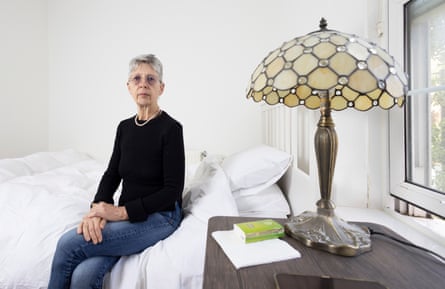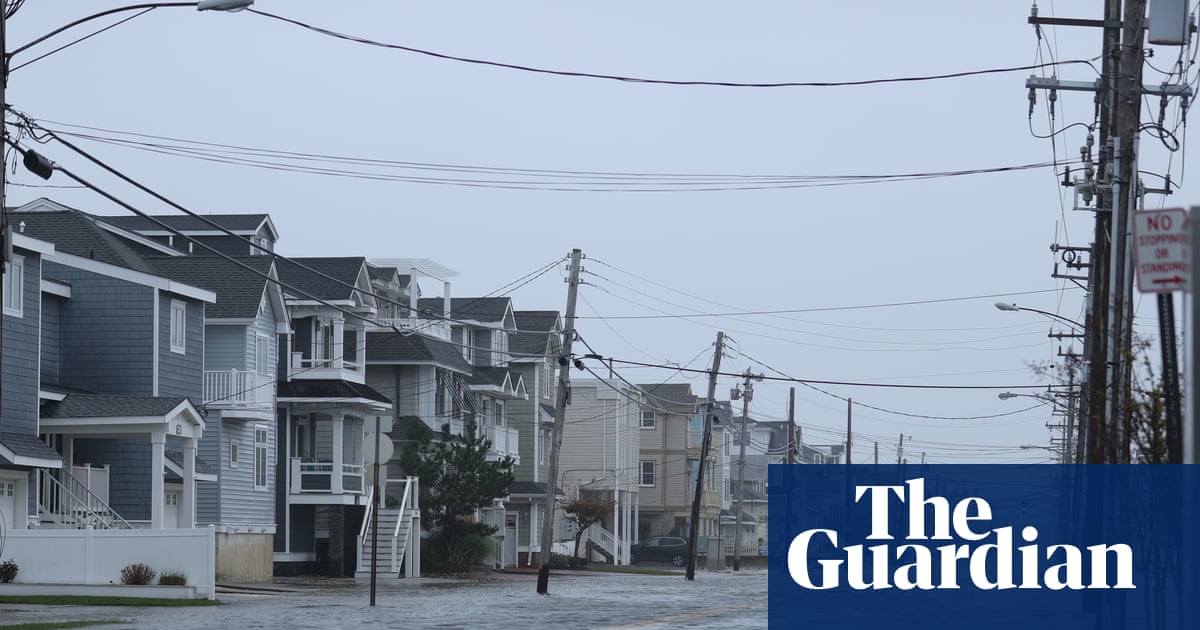Now that she is retired, Deborah Herring’s days are hers to fill – usually with leisurely walks, museums and trips to the theatre. But she still manages to spare a thought for her ex-colleagues at the private boarding school where she taught religious studies for 14 years. “In their nice, expensive Oxfordshire village, I think they’d be frankly horrified about my situation,” she says with a laugh.
Horrified that a few weeks ago she came home to find two strangers asleep on her sofa; horrified that she has to put up with an overflowing litter tray belonging to a cat that isn’t hers; above all, horrified that at the age of 65, she is about to leave a two-bedroom flatshare to move into a four-bedroom one where she will “probably be living with people whose combined age is less than my own”.
Herring initially made the move to flatsharing two years ago, when, fed up with living alone in a rented house near Banbury, she moved to London and into her current place, which she shares with a thirtysomething couple. “I would rather do anything than live out the rest of my life in the country, where there’s barely one bus an hour,” she says. Now, after a period of feeling “slightly like a third wheel”, she is moving into a mixed-use block of flats in Bermondsey, south London.
“I’m not going to have an elegant garden, and drink cocktails and have barbecues on my patio,” says Herring. Rather, she will share a kitchen with strangers, wait for twentysomethings to empty the washing machine, and try to find common ground with people who don’t remember a time before the internet. “It doesn’t actually bother me. I’ve got five children, so I don’t have a problem with young people,” says Herring, who has twice been married. Her teacher’s pension, coupled with a small income as a part-time A-level examiner, is enough to cover £1,000 a month in rent, plus the odd theatre ticket. “You’ve got to think about it as the chance to do something new and different – not as a comedown in the world,” she says.
If it sounds like a less-than-ideal setup for a pensioner, many more of us will soon have to adopt Herring’s attitude. According to the English Housing Survey, just 6% of households headed by someone over 65 are privately renting. But the Pensions Policy Institute (PPI) forecasts that this will almost treble to 17% by 2040. Online rental platform SpareRoom says that the era of flatsharing in later life may already be upon us: just 2.7% of its users were aged over 55 a decade ago, compared to 7.1% in 2024.

The proportion of over-65s in the private rental sector has remained relatively unchanged in the past two decades – largely, says Anna Brain, a senior policy researcher for the PPI, due to the introduction of Margaret Thatcher’s right-to-buy policy in 1980. Among the over-65s, “we’re not seeing a huge increase in private renting yet, because a lot of those people had the opportunity to buy their home in the 80s and 90s,” she says.
Many of these homes were not replaced with fresh council housing stock, leading to a lack in provision of socially rented properties. And yet today, more than 40% of the homes sold under the scheme are privately rented.
“The challenges that younger people face getting on the housing ladder have really significant long-term implications,” says Brain. “Behind that [right-to-buy] group, you have a whole cohort of people coming through who couldn’t get social housing, didn’t have the right to buy, and then were faced with rising house prices.” In short, many more of us will have to make peace with renting into our twilight years. It’s unclear, though, how many of us could afford it.
Andreas Savva, 68, pays £800 a month for a mould-ridden house in east London, which belonged to a friend’s mother. Savva’s ankylosing spondylitis – an inflammatory condition affecting the spine – makes his job in patient transport for a cancer charity increasingly difficult. “I can’t do the patients, so at the minute, I just move the vehicles around,” he says. The mould at home is exacerbating things: “It’s too toxic – it’s beginning to affect my lungs. I have to leave,” he says.
Savva used to live rent-free in a house belonging to his brother, but he had to move out when his brother died without a life insurance policy. He was forced into a series of precarious living situations – first in a hotel, where he paid through the nose for a room, and then in his current place, where the smell of mould soaks into his laundry and garlands the kitchen walls.
Now, the problem is that with a budget of £800 in a city where the monthly price of a one-bed routinely tops £1,300, he is unsure of where exactly he can go. “I hate the idea of sharing,” says Savva. “I hate the idea of a place where there are so many people using the toilet and the kitchen. But I’ve got no choice.”
“I should be retired, but I’m paying rent,” he says. “I need to keep working.” Though he has a small state pension and some money put aside, Cyprus-born Savva doubts he can stay in the UK. “I can’t just keep going on like this for ever,” he says.
Even dedicated savers are unlikely to be putting aside enough money to allow for rent or mortgage payments in retirement. “The UK pension system is based on the assumption that people reach retirement without housing costs,” says Brain. “There’s a huge concern that people aren’t saving enough.” The PPI conservatively estimates that you would need about £180,000 more in your pension pot to cover the cost of renting a one-bedroom flat through later life. “Generally, the people who we find in rented homes over 40 are not high-income households. So to be able to pay their rent today and set aside enough to pay their rent in retirement is going to be incredibly difficult,” she adds.
That’s assuming they find somewhere to rent in the first place. These days, 63-year-old Tamara Kocsubej spends an inordinate amount of time checking her SpareRoom account to see if anyone has responded to her pleas for a decent room in shared accommodation. “I’m checking it all day, every day,” says the Ukraine-born charity worker, who has rented in Nottingham and London since moving to the UK from Hungary.
Her recent stint as a lodger came to an end after just under a month of renting from a live-in landlord, where she felt “unwelcome all the time”. So she took a room in a three-person Airbnb for £950 a month. Before that, she rented a room in a six-bedroom house in north London, which soured when her twentysomething flatmates began to make comments about her age. “At the end of every day, I didn’t want to go back,” she says. “I never used to live with a closed door. Now, I close my door all the time.
“I actually like living with someone,” says Kocsubej. “I don’t want to live alone. But everywhere I look, people are in their 20s.” Many of them, she says, won’t even consider sharing with a 63-year-old. “I want to stay somewhere. I want to be part of the community. It’s making me wonder whether I should go back to Hungary. But all of my life is here.” Last she checked, she was number 146 on one non-profit’s waiting list for affordable housing. “Every day I check and I wait. That’s all I can do,” she says.

The UK housing sector could hardly be less prepared for an influx of older renters. Just 12% of households in England headed by someone over the age of 75 have step-free access to their home. A report published earlier this week by Age UK reported a huge shortage of housing suitable for an ageing population, finding that 44% of over-50s are worried about accessibility.
“When people talk about older people’s housing, they very often think of supported living,” says Age UK’s Lisabel Miles. “Actually, the vast majority of older people will be living in mainstream homes – not in some kind of specialist unit. And the vast majority of people will move when they’re younger and then age in that home.” The problem is that many existing properties are difficult to adapt – whether they contain plumbing that makes it hard for a bath to be replaced with a shower, or stairs that can’t accommodate a stairlift. Applying for a disabled facilities grant to cover the cost of adaptations is slow: on average, it takes 247 working days to get such a grant approved and the work completed. Then there’s the time that private renters may well have to expend on convincing their landlord to make the changes in the first place. “I’m desperate to find somewhere, but I’ve had to turn down rooms where the stairs just weren’t doable,” says Savva.
Of course, there are social advantages to housesharing in later life. Digital marketer Nick Henley founded Cohabitas, an accommodation-sharing site for over-40s, when his father died and his mother was left alone in a three-bedroom house. “She was lonely,” says Henley. “She would ride the buses just to talk to people.” Though his mother quickly dismissed the idea of living with other people in her mid-70s (and never did actually end up sharing), he launched the site anyway, and says that today business has never been better, as a result of rent hikes, rising utility bills and a desire for connection. “The oldest person I’ve ever helped find a flatmate was probably 88,” he says. He admits that if given the choice, most people wouldn’t choose to share a house with strangers, but adds: “Many people would love to live in a flat with a friend, a partner or a family. They would not like to live in a flat on their own.”
Herring supports this hypothesis: “It’s just nice knowing there are bodies around,” she says. “I’ve been surrounded by people all my life. It would be weird to now suddenly be living alone.”
A flat of her own is all that Sarah (not her real name), a 55-year-old paralegal, has ever wanted. Despite being employed for the past 21 years, the self-described “veteran renter” from Surrey could never afford to buy. “There’s an assumption made that when you are a certain age, you are mortgaged, you’re married, you’ve got kids,” she says. “There’s a lot of ageism when you go to view places. It’s like a job interview or dating. I don’t want to be doing this at my age.”
After 12 years in a beloved bedsit – “it wasn’t much,” she says, “but it was mine, where I could do whatever I want, whenever I want” – she was tossed into the SpareRoom arena a few months ago when her landlord wanted the house back for her own family. After years of paying £500 a month for a flat with no central heating or washing machine, she realised she could probably never again afford to live alone.
The flat hunt was brutal: months of messages, interviews and bruising disappointments. Each time she thought she’d found somewhere she might like to live, an email along the lines of “we just don’t think you’re suitable” would land in her inbox. “They may as well have said, ‘You’re too old.’ But what do they think a 55-year-old is going to do? Suddenly keel over and have a heart attack? It was upsetting, quite frankly,” she says.
With a decade still to go until she reaches state pension age, she’s uncertain about whether she could stop working. A few weeks ago she found a room via a care-and-share scheme, offering companionship and light help to a woman in her 80s in exchange for affordable rent. “It’s fine,” she says. “I get to live with some dignity here. But then I remember that, again, I’ll eventually have to leave.”

 3 weeks ago
18
3 weeks ago
18

















































